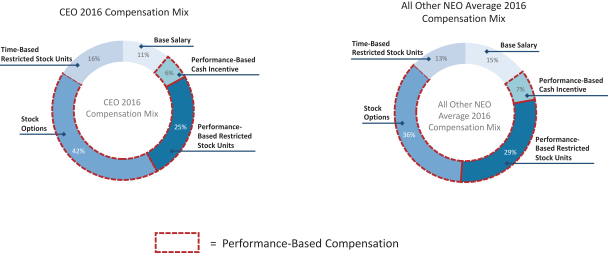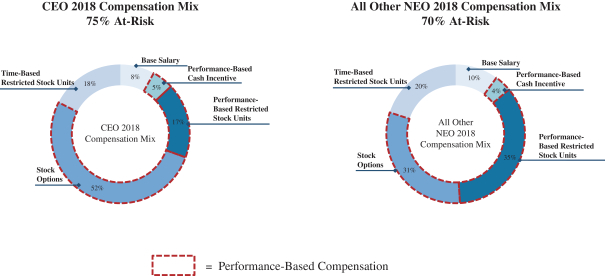It is the Company’s policy to have a diversity of skills, professional experience, education, associations, achievements, training, points of view and individual qualities and attributes represented on the Board of Directors. The Nominating/Corporate Governance Committee considers the diversity of the Board of Directors when evaluating candidates for election orre-election to the Board of Directors.
The Nominating/Corporate Governance Committee’s goal is to assemble a Board of Directors that brings to the Company a variety of perspectives and skills derived from high quality business and professional experience. In doing so, the Nominating/Corporate Governance Committee also considers candidates with appropriatenon-business backgrounds.
In addition to the foregoing, the Nominating/Corporate Governance Committee Charter and Corporate Governance Guidelines set forth minimum criteria for director nominees. The Nominating/Corporate Governance Committee may also consider such other facts as it may deem are in the best interests of the Company and its stockholders. The Nominating/Corporate Governance Committee does, however, believe that at least one, and preferably several members of the Board of Directors, meet the criteria for an “audit committee financial expert” as defined by SEC rules. The following paragraphs provide information as of the date of this proxy statement about the specific experience, qualifications, attributes and skills of each nominee and current member of the Board of Directors that led the Board to conclude that such person should serve as a director. In addition to the information below regarding each Board member, we alsoWe believe that all of our directors should have a reputation for honesty, integrity and highest ethical standards. They each have demonstratedstandards, and should demonstrate business acumen, an ability to exercise sound judgment and a commitment to serve the Company.
Class III Directors Nominated for Re-election at the 2017 Annual MeetingBoard Self-Assessment
The nominationNominating/Corporate Governance Committee ensures that each member of Kevin C. Gorman, Ph.D. the Board, the Committees, and the Chair of the Board are annually assessed annually aimed at enhancing effectiveness. Directors complete a number of different evaluations in order to provide performance feedback and suggestions for electionimproved effectiveness or contributions. The assessments are done by way of a questionnaire conducted by our external legal counsel, Cooley, LLP. The assessments are treated on a confidential basis, with the results tallied on an anonymous basis for review. The results of the evaluation are analyzed by our Chief Legal Officer, the Nomination/Corporate Governance Committee and the Board, who decide whether any changes are needed to the Company’s Board’s processes, procedures, composition or Committee structure. The evaluation carried out in 2018 indicated that all individuals and groups were effectively fulfilling their responsibilities.
Board of Directors is based on the fact that as Chief Executive Officer of the Company, Dr. Gorman has extensive knowledge of our product candidates, our employees and the industry in which we operate. Dr. Gorman has also demonstrated exceptional leadership skills, sound business judgment and a strong commitment to the Company.Education
The nominationBoard recognizes the importance of Gary A. Lyons for election ongoing director education. In order to the Company’s Boardfacilitate member of Directors is based on Mr. Lyons’ extensive business development and corporate governance experience and, as the Company’s former Chief Executive Officer, his in-depth understanding of the Company’s product candidates, management and culture. With this history with the Company and management, Mr. Lyons brings a unique perspective and point of view to the Company’s Board of Directors.
The nomination ofAlfred W. Sandrock, Jr., M.D., Ph.D. for election to the Company’s Board of Directors is based on his extensive experience and credentials in the biotechnology industry as an Executive Vice President of Biogen and his extensive experience in successfully leading development teams. In addition, Dr. Sandrock’s medical expertise in neurology and his scientific background provide a unique contribution to the Board of Directors.
Class I Directors Continuing Until 2018 Annual Meeting
The continued serviceDirectors’ educational development, the members of Joseph A. Mollica, Ph.D. on the Company’s Board of Directors is based is based on his years of experience in the pharmaceutical industry including his wide range of leadership experience, roles and responsibilities with companies such as Pharmacopeia Drug Discovery, Inc., Accelrys, Dupont Company, Dupont Merck Pharmaceutical Company and Ciba-Geigy and his service on a number of life science company Boards. Dr. Mollica contributes a significant history and depth of experience in the biopharmaceutical industry to the Board of Directors.
12
The continued service ofGeorge J. Morrow on the Company’s Board of Directors is based on his extensive commercialization experience at Amgen, his broad executive experience at GlaxoSmithKline Inc., and his years of experience in corporate governance as a board member of several publicly traded companies. Mr. Morrow’s board, leadership experience and commercialization expertise prove valuable strategic insights to the Board of Directors.
The continued service of William H. Rastetter, Ph.D. on the Company’s Board of Directors is based on Dr. Rastetter’s scientific and technical expertise combined with his business experience in leading rapidly growing companies in the life science industry. The Company’s continued growth is dependent on scientific and technical advances, and the Board of Directors believes that Dr. Rastetter offers both strategicregularly meet with management and technical insight into the risksare given periodic presentations on our business and opportunities associated with our business. In addition, Dr. Rastetter’s board and executive leadership experience at other life science companies provides valuable strategic and governance insight torecent business developments. Members of the Board of Directors as a whole.
Class II Directors Continuing Until 2019 Annual Meeting
The continued service of Corinne H. Nevinnyalso attend dinners on the Company’sevening before regularly scheduled Board meetings. Generally, at these dinners the Board meets with senior decision-makers within the Company or outside experts in order to enhance the Board’s understanding of our business and affairs. In addition, on an annual basis an external expert meets with the Board to discuss new developments relating to corporate governance and the operation of public company boards. The Company also provides funding for members of the Board of Directors is based on her global expertise as a prior President for Global Operations of Edward Lifesciences, Inc., her financial background as a prior Chief Financial Officer for Edwards Lifesciencesto attend outside director continuing education programs sponsored by educational and Tularik, Inc., her experience as board and audit committee members at other publicly traded biotechnology companies, and her capital markets experience as Executive Director-Health Care Group at Warburg Dillon Read LLC. Her combination of financial, global and capital markets experience has in the past, and will in the future, help guide the Company’s financial and capital strategies.institutions.
The continued service of Richard F. Pops on the Company’s Board of Directors is based on his leadership experience and track record for growing companies, his strength in business strategy and his financial acumen and capital markets experience. In addition, Mr. Pops is recognized for his service to the biopharmaceutical industry as a member of the Boards of the Biotechnology Industry Organization and the Pharmaceutical Research and Manufacturers of America. His breadth and range of industry experience from operations and strategy is a significant contribution to the Board of Directors.
The continued service of Stephen A. Sherwin, M.D. on the Company’s Board of Directors is based on his experience and credentials in the biotechnology industry as the former Chief Executive Officer of Cell Genesys, Inc., the former chairman and co-founder of Abgenix, Inc., the chairman and co-founder of Ceregene, Inc., and his positions at Genentech, Inc. and the National Cancer Institute. Dr. Sherwin is also currently Chairman Emeritus of the Biotechnology Industry Organization. In addition to his biotechnology credentials, Dr. Sherwin’s medical expertise in internal medicine and medical oncology provides a unique contribution to the Board of Directors.
Identification and Evaluation of Nominees for Director
The Nominating/Corporate Governance Committee identifies nominees for director by first evaluating the current members of the Board of Directors willing to continue in service. Current members with qualifications and skills that are consistent with the Nominating/Corporate Governance Committee’s criteria for service and who are willing to continue are considered forre-nomination, balancing the value of continuity of service by existing members of the Board of Directors with that of obtaining members who would offer a new perspective. If any member of the Board of Directors does not wish to continue in service, or if the Board of Directors decides not tore-nominate a member forre-election, the Nominating/Corporate Governance Committee identifies the
13




